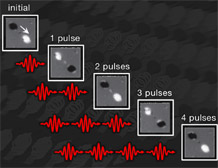Scientists 'record' magnetic breakthrough

An international team of scientists has demonstrated a revolutionary new way of magnetic recording which will allow information to be processed hundreds of times faster than by current hard drive technology.
The researchers found they could record information using only heat – a previously unimaginable scenario. They believe this discovery will not only make future magnetic recording devices faster, but more energy-efficient too.

Experimental images showing the repeated deterministic switching of nano islands. Initially the two nano islands have different magnetic orientation (black and white respectively). After the application of a single pulse, the magnetic direction of both islands changes. Further pulses repeat the process, switching the magnetic state back and forth.
The results of the research, which was led by the University of York’s Department of Physics, were reported in the February edition of Nature Communications.
York physicist Thomas Ostler said: “Instead of using a magnetic field to record information on a magnetic medium, we harnessed much stronger internal forces and recorded information using only heat. This revolutionary method allows the recording of Terabytes (thousands of Gigabytes) of information per second, hundreds of times faster than present hard drive technology. As there is no need for a magnetic field, there is also less energy consumption.”
The multinational team of scientists included researchers from Spain, Switzerland, Ukraine, Russia, Japan and the Netherlands. Experimental work was carried out at the Paul Scherrer Institut in Switzerland, the Ioffe Physical Technical Institute of the Russian Academy of Sciences and Radboud University Nijmegen, Netherlands.
Dr Alexey Kimel, from the Institute of Molecules and Materials, Radboud University Nijmegen, said: “For centuries it has been believed that heat can only destroy the magnetic order. Now we have successfully demonstrated that it can, in fact, be a sufficient stimulus for recording information on a magnetic medium.”
Modern magnetic recording technology employs the principle that the North pole of a magnet is attracted to the South pole of another and two like poles repulse. Until now it has been believed that in order to record one bit of information – by inverting the poles of a magnet – there was a need to apply an external magnetic field. The stronger the applied field, the faster the recording of a magnetic bit of information.
However, the team of scientists has demonstrated that the positions of both the North and South poles of a magnet can be inverted by an ultrashort heat pulse, harnessing the power of much stronger internal forces of magnetic media.
Further information
- Department of Physics
- The paper “Ultrafast heating as a sufficient stimulus for magnetization reversal in a ferrimagnet” was published in Nature Communications in February.
- The research team included scientists from University of York; the Instituto de Ciencia de Materiales de Madrid, Spain; Paul Scherrer Institut, Switzerland; College of Science and Technology, Nihon University, Japan; Institute of Magnetism, Kiev, Ukraine; the Ioffe Physical Technical Institute of the Russian Academy of Sciences, Russia; Radboud University Nijmegen, Institute for Molecules and Materials, Netherlands.
- The work was partially supported by de Nederlandse Organisatie voor Wetenschappelijk Onderzoek, NanoSci-E+ program, Foundation for Fundamental Research and the Technology Foundation; the Russian Foundation for Basic Research, the European Community’s Seventh Framework Programme, the Spanish MICINN project and the European Research Council under the European Union’s Seventh Framework Programme.
